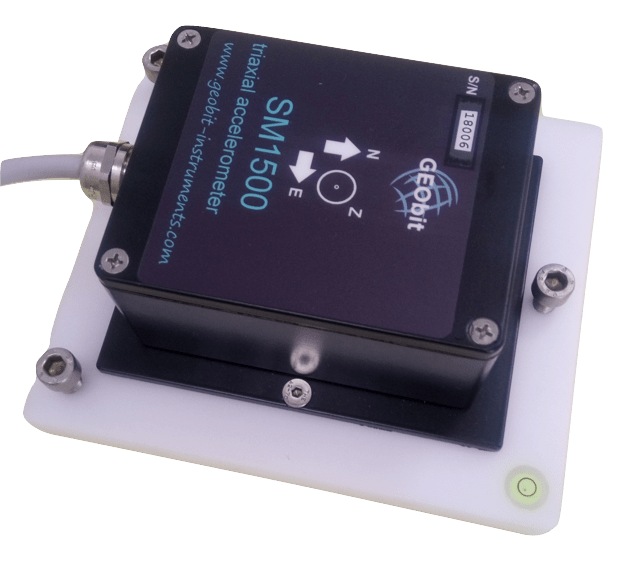Coupled Hydrodynamic and Structural Monitoring of Floating Offshore Wind Turbine Model
1. Introduction
A group of researchers, including graduate and undergraduate students of the University of Patras, Department of Civil Engineering [1], under the coordination and supervision of Prof. A. Dimas [2], developed a physical model of a floating offshore wind turbine generator in geometrical scale of 1:100 (Fig. 1). The coupled hydrodynamic and structural behavior of the model at stormy seas, under operational and parked conditions, was tested in the Wave Basin of the Hydraulic Engineering Laboratory of the Department [3], which is equipped with a paddle wavemaker. Several sea conditions were tested corresponding to wind strength up to 12 in the Beaufort scale.
GEObit-instruments designed and provided all the hardware to measure, monitor and record instantaneous acceleration at the top and at the base of the turbine pylon.
Picture 1
The
Picture 2
The GEObit SM1500 acceleration sensor
Picture 3
The floating wind turbine physical model in the Wave Basin
2. Experimental Configuration
Two GEObit SM1500 [4] sensors (Fig. 3) combined with SRi32S [5] data-loggers (Fig. 1) were used for the acceleration monitoring.
The SM1500 sensors had to be modified to enable their attachment to the turbine model. The sensing elements were placed on ring PCB boards (Fig. 4) and the sensor electronics were housed separately into the typical SM1500 enclosure (Fig. 5). Extra attention was paid to create lightweight sensing parts and connection cables for avoiding add extra weight and tense to the model. Three acceleration elements were orthogonally placed on each ring; therefore, all axes were monitored at the top and at the bottom (sea level).
The acceleration signal from the modified accelerometers was recorded by two high-resolution SRi32S dataloggers (Fig. 6). Real-time signal plot was obtained at the Laboratory’s computer, so the researchers were able to monitor in real time the effect of the waves on the turbine model (Fig. 7).
In addition, one wave gauge at the seaward side of the wind turbine model (Fig. 3) was continuously measuring the free-surface elevation due to the incident waves.
Several regular and irregular wave conditions were reproduced in the Wave Basin in order to test the dynamic behavior of the floating offshore wind turbine under operational (wind speed less than 25 m/s) and parked (wind speed more than 25 m/s) conditions; the latter include severe wave conditions.
Picture 4
The GEObit SM1500 acceleration sensor upper ring
Picture 5
The GEObit SM1500 and SRi32S sensor – dataloggers
Picture 6
The wind turbine physical model and the GEObit acceleration recording system
Picture 7
Acceleration plot on the PC
3. Results
The results of this project will be announced soon.
3. Acknowledgments
The following research team contributed to the successful implementation of this project:
- Liras Vasilios, Undergraduate Student (Univ. Patras, Department of Civil Engineering)
- Vavouraki Argiro, MSc Student (Univ. Patras, Department of Civil Engineering)
- Galani Kostantina, Postdoctoral Research Associate (Univ. Patras, Department of Civil Engineering)
- Dimou Ioannis, Laboratory Staff (Univ. Patras, Department of Civil Engineering)
- Dimas Athanassios, Professor (Univ. Patras, Department of Civil Engineering)
- Spiliotopoulos Athanasios, Electrical Engineer (GEObit-Instruments)
- Germenis Nikos, MSc Electronics Engineer (GEObit-Instruments)
5. References
[1]: http://www.civil.upatras.gr/
[2]: http://www.civil.upatras.gr/en/Proswpiko/faculty/entry/DimasAthanasios/
[3]: http://www.hydraulics.civil.upatras.gr/en/Infrastructure/Egkatastaseis/WaveBasin/
[4]: https://geobit-instruments.com/accelerometers-strong-motion-sensors/
[5]: https://geobit-instruments.com/seedlink-digitizers-sri32/







